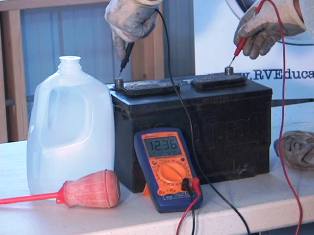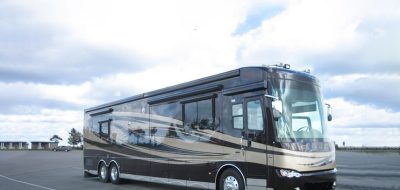
I was recently asked a question and felt like the answer could be useful to lots of RVers, so I am using the question as the topic for this article.
Q: Hi Mark, we live in Colorado and we are preparing our RV for storage. I just had the RV winterized, but I am concerned about how or what to do to store my RV batteries. Any advice would be appreciated.
A: The two most common causes for RV battery failure are undercharging and overcharging. Undercharging is a result of batteries being repeatedly discharged and not fully recharged between cycles. If a battery is not recharged the sulfate material that attaches to the discharged portions of the plates begins to harden into crystals. Over time this sulfate cannot be converted back into active plate material and the battery is ruined. This also occurs when a battery remains discharged for an extended period of time, like during storage. Sulfation is the number one cause of battery failure. The second leading cause of battery failure is overcharging. Overcharging batteries results in severe water loss and plate corrosion. With that said let’s look at how to properly store your RV batteries.
Before we talk about storing the batteries we need to talk about battery safety. Lead acid batteries contain sulfuric acid which is extremely corrosive and can cause severe burns or even blindness. And the hydrogen gas that batteries produce, when they’re charging, is very explosive. When you work around batteries you need to wear safety glasses and gloves, remove all jewelry and do not smoke or use any open flames.
Caution: If you accidentally get battery acid on your skin, flush it with lots of water and if it gets in your eyes flush with low pressure water for 15 minutes and call a doctor.
When you put the RV in long term storage it’s a good idea to remove the batteries and put them in storage too. This is quite simple to do. The first thing we want to do is visually inspect the batteries for any obvious damage. Any fluid on or around the battery may be an indication that electrolyte is leaking from the battery. A damaged or leaking battery should be replaced immediately. Whenever you remove any battery always remember to remove the negative terminal or cable first, and then the positive cable.
Battery Tip: When you remove a battery turn off the ignition switch, all electrical switches, and any battery disconnect switches before you disconnect the battery cables. Whenever you remove any battery cables label them first so you remember how they go back on the battery next spring. When you reinstall the battery do it in the reverse order. Install the positive cable first and then the negative cable.
Clean the batteries with a 50/50 mixture of baking soda and water if necessary. Now you can check the electrolyte level in each cell and add distilled water if necessary. The minimum level required, before charging a battery, is at the top of the plates. If it’s below the plates add enough distilled water to cover the plates before you charge the battery.
Test the battery state of charge with a voltmeter or hydrometer and charge any batteries that are at or below 80% state of charge. An 80% charge is approximately 12.5 volts for a 12-volt battery and 6.25 volts for a 6-volt battery. Lead sulfation starts when a battery state of charge drops below 80%. After charging the batteries check and fill each cell to 1/8 inch below the fill well with distilled water. Overfilling cells will cause battery acid to overflow.
Caution: Batteries should only be charged in a well ventilated area and keep any sparks and open flames away from a battery being charged. Check the electrolyte levels before and after charging batteries.
A discharged or partially charged battery will freeze much faster than a charged battery. Store the batteries in a cool dry place but not where they could freeze. Batteries in storage will loose a percentage of current through internal leakage. It’s not uncommon for a battery to discharge up to 10% a month when it is being stored. Cold temperatures slow this natural discharge process down and warmer temperatures speed the process up. Test the stored battery state of charge every month and charge batteries that are at or below an 80% state of charge.
Completely charge the batteries before re-installing them next spring. For optimum performance you can equalize the batteries after they are fully charged. Battery equalizing is a controlled overcharge on a flooded lead acid battery after it has been fully charged. Equalizing reverses the buildup of negative chemical effects like stratification, a condition where the water and acid separate and the acid concentration is greater at the bottom of the battery than at the top. Equalizing also helps remove some of the sulfate build up on the battery plates. Equalizing is fine as long as there is not excessive heating or electrolyte boiling over. Some battery chargers have an equalization cycle or charge setting. After charging a battery, set the battery charger on equalizing voltage and charge it again. You need to test the specific gravity every hour during equalizing. Equalization is complete when the specific gravity readings no longer rise during the gassing or bubbling stage. Keep in mind if equalizing a battery is done correctly the electrolyte should not boil over but it will create a good bit of bubbling, and when the cycle is finished you will need to add distilled water to the cells.
Note: If you don’t feel comfortable working on or around lead acid batteries have battery maintenance done by an authorized service center.
If you decide to leave the batteries in the RV while it is in storage remember to check the state of charge monthly and charge any batteries at or below an 80% charge. If your RV converter charger charges the battery(s) at a constant rate (around 13.5 volts) this is too high for a float charge and can deplete the electrolyte over time. In this situation plug the RV in periodically and allow the converter charger to charge the battery(s) for 8 to 12 hours. Some RV converter multi-stage chargers and aftermarket chargers are designed to maintain a float charge on the battery without removing the batteries from the RV. Remember, for the converter charger to work the RV will need to be plugged in to electricity.
Happy Camping,
Mark Polk








Terry Veenendaal
My 5th wheel is equipped with a 120 watt solar panel and two six volt batteries in series. Do I need to take the batteries out during our cold Manitoba winters?
Vicki
We are storing a Roadtreck in Europe for 3-4 months at a time. It is outside and we cannot remove batteries or plug in anything. We were thinking of buying a solar battery maintainer. Is this a good idea? Do we need a pulse one? Would it be better to just buy a larger solar setup that would maintain battery and also supply some solar power for dry camping? We don’t want to invest more than about $300.
Sharilewis
I have a Miata that has never had the battery removed for charging and is stored for 7 months during the winter. It also has one of the aforementioned float chargers continually connected and active. The current AGM battery is seven years old.
UB12350
Ron
Rookie here: Without any forethought, in November I bought a 1995 Winnebago Sunrise Class A. I am storing it outside my home in Colorado. Is there any action that I should be taking to protect the batteries such as by starting the home weekly and leaving it run for 30 minutes or so. Or should I just bring the batteries inside and put them on a charger? The motorhome can’t be driven since the driveway is steep and it is snowcovered, which will be the situation until March. Thanks.
Thor
Also in a freezing climate. Have TT. Didn’t use last winter and batteries got close to freezing–but didn’t. Used small charger on a trickle charge for 48 hours in garage.
Tow vehicle has space for two batteries (used when had overhead camper). Even though the TT batteries are deep cycle I wonder if I can’t just keep my TT battery in the truck (which gets used every other day) and run my cables from the truck battery to the TT battery.
I have very heavy cables (heavier than jumper cables) that can be attached to the post on both batts. (I always get batts with posts and side mounts) The side mount on my truck battery is connected to the alternator and starter–it starts is the coldest weather.
As long as my cables are connected in parallel (plus to plus and minus to minus) can I just keep the deep cycles charged by the truck? Thor [email protected]
oes tsetnoc
how to mantenance loose batterey, i had lose power batterei , can i resolve it
Shelly
Helloooo Thomas, did you not read the article?
The article clearly states:
“When you put the RV in long term storage it’s a good idea to remove the batteries and put them in storage too.
Battery Tip: When you remove a battery turn off the ignition switch, all electrical switches, and any battery disconnect switches before you disconnect the battery cables. Whenever you remove any battery cables label them first so you remember how they go back on the battery next spring. When you reinstall the battery do it in the reverse order. Install the positive cable first and then the negative cable.”
GEESH!
Thomas Becher
Except for the last poster nowere did you say disconnect the battery. The Propane gas detector takes power all the time as do some radios. They will kill your battery soon enough. better yet take the battery into the house or somewhere that will not freeze. That way if it goes dead(from natural discharge) it will still be able to be charged. But if a battery freezes it’s shot and may burst.
Ian McKee
Did anyone ever hear of AGM batteries? They’re sealed so forget battery acid.
I have four 6 v batteries in my fifth wheel (there are others than motor coaches) and I’ve installed a cutoff switch so I can disconnect the batteries during storage.
Works for me!
dan thomas
will there be any damage to my diesel engine if i mix my old oil into the fuel tank it has a 100 gal. tank.
Darthvagrant
If the voltage measured AT THE BATTERIES is 13.7 volts, that should be sufficient to initiate a slow charge. That is a voltage value more in keeping with normal “12V system
voltage”, albeit a little high for continued battery connection after a full charge. If you’re measuring the voltage elsewhere, check it at the batteries. To initiate a charge, an initial
voltage of somewhere around 14.2-14.4 volts would be appropriate. A Cytek or Battery Tender will provide this voltage initially, tapering down to a ‘float’ of about 12.8-13 volts.
.
I leave all three batteries in situ and keep a Cytek or Battery Tender “float charger” connected continuously when the RV is inactive. I have a Miata that has never had the battery removed for charging and is stored for 7 months during the winter. It also has one of the aforementioned float chargers continually connected and active. The current AGM battery is seven years old. Batteries, particularly the “golf cart” 6 volt batteries (in series) in my motorbox are waaaaay too heavy to remove for charging IMHO. (Removal not being necessary as explained)
.
The foregoing is assuming there is 120 V continuously available where the vehicle is stored.
Marcel Charpentier
I have a question I owne a class B (Leisure Travel) i have just dicarded my 2 12 volts deep cycle batteries and replaced them with 2 6 volts batteries connected in series> My RV is plugged into shore prower and normally the batteries would charge themself but after 4 days the batteries are still discharged,I Tested the RV charger and it is producing 13.70 volts
HELP?